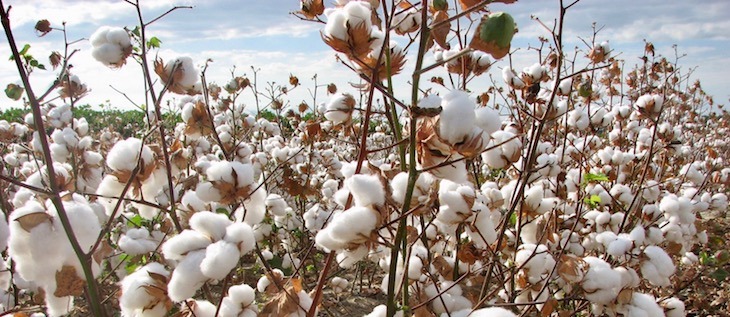Cotton planting expected to hit estimates despite weather, bollworm concerns
by July 16, 2019 6:10 pm 2,035 views

Bad weather has hampered cotton growers in 2019, the growing stages vary greatly from field to field, and bollworm problems loom. But, the state is on pace to hit its United States Department of Agriculture planted acreage estimates from earlier this year.
“Things are coming on pretty well,” Bill Robertson, extension cotton specialist for the University of Arkansas System Division of Agriculture said. “Some of our older cotton looks really good. We’ve been blooming for a couple of weeks. It started with good horsepower with a lot at nine to 10 nodes above white-flower at first flower. Some of the younger cotton has struggled a bit and nodes above white-flower won’t be quite as good. But it’ll still be okay.”
The real issue is that the cotton crop maturity is “so strung out,” Robertson said. Growers have some cotton beginning to square along with cotton still at cotyledon, the stage at which the first leaves appear from a germinating seed.
“That’s a crazy difference in age but we were only at 50% planted going into Memorial Day weekend. During that three-day weekend, everyone who had hands to drive a tractor had them running. That meant a lot of cotton was planted that weekend,” he added.
In March, the USDA estimated that Arkansas cotton farmers would plant 580,000 acres. As the planting season progressed, it didn’t seem as if farmers would hit that target number.
“So, I thought by the end of May we’d barely bust 500,000 acres of cotton. Now, I think maybe the 580,000 acres is pretty doggone close. It’ll be interesting to see what the final numbers are. There were a good number of acres intended to be planted to corn that went to cotton,” he said.
Staying on top of weed control in the crop has been a challenge, but it’s always a challenge in the Arkansas Delta with the high winds and unpredictable weather. The cotton crop color has been good and it looks “clean,” he added.
Spotty rainfall across the Cotton Belt is keeping the cotton crop active. In 2018, cotton farmers were already irrigating fields due to the dry weather last July.
“This year, we keep getting rainfall and our nodes above white-flower is hanging in there really well on nearly all our cotton. The prospect for our younger cotton also looks good. So, if Mother Nature throws a few 100-degree days at us we’ll be in better shape to handle them,” he said.
Bollworms will be an issue this year and it’s just a matter of time.
“Entomologists are saying our Fourth of July bollworm moth flight will come to fruition. At the same time, plant bug numbers, even in our older cotton, are running above threshold. The corn silks are drying down and plant bugs are looking for a new host,” Robertson said.
Robertson said that both he and Gus Lorenz, extension entomologist for the University of Arkansas System Division of Agriculture, are concerned about what they’re hearing about bollworms out of Texas. Producers may have to go back to thresholds based on bollworm egg counts.
“Obviously, we have a late crop and can’t give up days,” he said. “If the worms come in and we lose some fruit, we don’t have the luxury of making it up. So, we really have to watch what’s happening to our south with boll-fill coming quickly … When you farm 5,000 acres of cotton, you can’t have perfect timing. But we don’t need to have our late cotton to be green and full of horsepower at the end of the season. It’s hard to get those plants mature and to shut down.”
